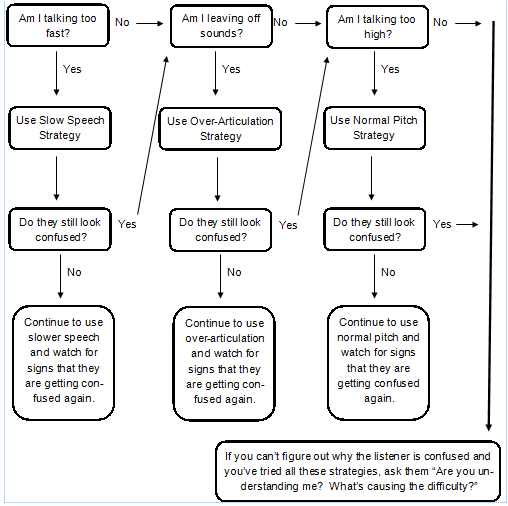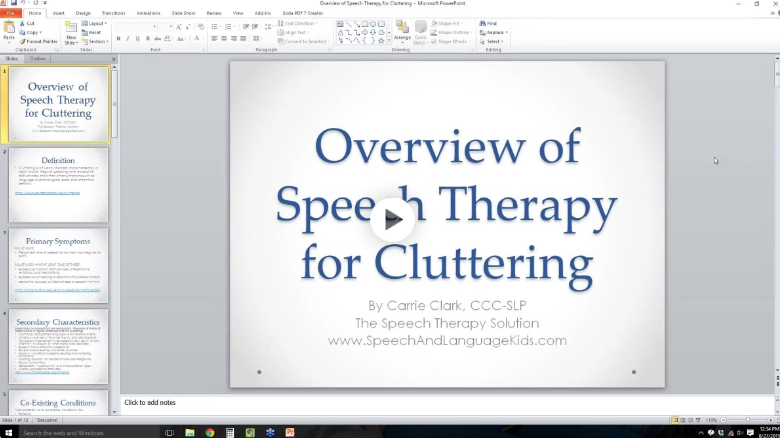What Is Cluttering?
According to the Stuttering Foundation, Cluttering is defined as follows:
“Cluttering is a fluency disorder characterized by a rapid and/or irregular speaking rate, excessive disfluencies, and often other symptoms such as language or phonological errors and attention deficits. “
Children who use cluttered speech are often very difficult to understand and have speech that sounds jerky or too fast. They may have irregular pauses or may speed up and slow down without cause during speech. As secondary symptoms, they may have difficulty organizing their thoughts verbally, they may leave many sounds out of words, and they may use irregular pitch or intonation.
What are the Symptoms of Cluttering?
If a child’s speech seems very fast and their intelligibility improves when they slow down, they may be experiencing cluttering. Symptoms of cluttering include:
- excessive coarticulation resulting in the collapsing and/or deletion of syllables and/or word endings;
- excessive disfluencies, which are usually of the more nonstuttering type (e.g., excessive revisions and/or use of filler words, such as “um”);
- pauses in places typically not expected syntactically;
- rapid and/or irregular speech rate; and
- unusual prosody (often due to the atypical placement of pauses rather than a “pedantic” speaking style, as observed in many with autism spectrum disorder).
Cluttering Therapy
If your child has received a diagnosis of cluttering, it is important to teach him some strategies to compensate for this. There is no “cure” for cluttering but children can be taught techniques that will help them be understood by others. For most of these children, the first step is making them aware that it’s happening. Once they become aware that someone is having trouble understanding them, they can use the learned techniques to fix the communication breakdown. Here is a flow chart that explains how these strategies can be used once a communication breakdown is noticed:

Here is how you can describe these strategies to your child:
Cluttering Strategy #1: Slow Speech
When people clutter, they often speak very quickly or with an irregular rate (adding extra pauses). This makes it very hard for the listener to understand. When this happens, you can use a strategy called slow speech. To do this, you will use an overly-slow rate to make sure you don’t speed up again. To help you with his, come up with a strategy that works to remind you to keep doing it. This might be increasing natural pauses, taping a rhythm on your leg or with your toe, or another strategy that you come up with. This will help your listener understand what you are saying.
- Homework: Practice reading sentences or paragraphs from a book while using slow speech and the strategy you chose. Think about how it feels when you speak like this and how it sounds. Read to an adult and have them give you feedback on how you sound.
Cluttering Strategy #2: Over-Articulation
When people clutter, they often leave out sounds or smash them all together. If someone is having trouble understanding you, it is important to try to exaggerate saying every sound so you know they are all there. This is called over-articulation. You exaggerate each sound you say to the point that it may sound a little silly to you. This will help your listener understand what you are saying.
- Homework: Practice reading sentences or paragraphs from a book while using over-articulation. Think about how it feels when you speak like this and how it sounds. Read to an adult and have them give you feedback on how you sound.
Cluttering Strategy #3: Normal Pitch
When people are cluttering, they often speak with a pitch that is too high, too low, or too up and down. The pitch of your voice is how high or low it sounds. It is important to find the “Just Right” pitch for your voice. Practice saying these sentences very high and then very low. After that, use a normal pitch to say them. While you’re saying them, think about how your voice and throat feels while you use a normal pitch and what it sounds like. This will help you remember when you realize you’re using a pitch that’s too high or too low. Being able to come back to this normal pitch will help your listener understand you.
- I walked my dog in Kansas City last night.
- Sometimes, I like to eat mashed potatoes and corn.
- When I am bored, I like to ride my bike around the neighborhood.
- It’s a beautiful day outside today, don’t you think?
- This is how I use my normal pitch.
- Homework: Practice reading sentences or paragraphs from a book while using a normal pitch. Think about how it feels when you speak like this and how it sounds. Read to an adult and have them give you feedback on how you sound.
What’s Next for Cluttering?
Once your child can use these strategies with the assigned homework activities, try having your child use them in a conversation with you using the flow-chart above. Show your child that you are confused (with your facial expression) and have him try the strategies to see which one works. Eventually, you will be able to remind your child to use this concept during conversations with other people as well.

About the Author: Carrie Clark, MA CCC-SLP
Hi, I’m Carrie! I’m a speech-language pathologist from Columbia, Missouri, USA. I’ve worked with children and teenagers of all ages in schools, preschools, and even my own private practice. I love digging through the research on speech and language topics and breaking it down into step-by-step plans for my followers.
Fun Fact: I sunburn very easily, it’s kind of ridiculous. I have to be very careful when out in the sun, especially if we travel South at all.
Connect with Me:




Do you have another strategy for non-readers?
Children on the ASD spectrum sometimes clutter, and slow speech approach is working, but visual/motor impairment delays make the reading strategy difficult for these children.
Sure! If you’re working with a non-reader, simply have them describe pictures or use carrier phrases instead. For example, you could show the child action pictures and have the child say “she is ____-ing” or “he is ____-ing” while doing these activities.
How do you write a measurable goal on an IEP to measure reduced rate and over articulation?
You have two options here, you could write goals for the knowledge of the techniques (will define and demonstrate slow speech/over-articulation when requested). Or, you could write a goal for overall intelligibility as a result of using those techniques. That would look like, “During a conversational speech sample, Student’s overall intelligibility will be rated at a 4 or higher on the following rubric by the speech-language pathologist (or an unfamiliar listener if you have someone who could listen to it for you, principal maybe):” and then you write down the actual rating scale you’re going to use where 1 would be completely unintelligible, 5 would be completely intelligible, and the rest would be whatever you want them to be, like “fewer than # unintelligble words” or “intelligible most of the time”.
I am an adult who clutters what is the cause of cluttering. I never cluttered my speech as a child, instead I started when I was 13. What is the cause of cluttering?
Check out this information on the causes of cluttering and stuttering in children: http://www.asha.org/PRPSpecificTopic.aspx?folderid=8589935336§ion=Causes
I have been looking for a speech therapist who specializes in cluttering for my 19 year son with Aspergers in Connecticut. Can you provide any information?
Have you ever gone to: stutteringspecialists.org? On the left side, you will see a tab that says FIND A SPECIALIST. Click on that, and then find the country and state in which you live. I did it just now, and found 3 in CT. Hopefully, one of them can help …??
I am 15 years old. I have been dealing with cluttering as long as I remember. I feel so anxious when presenting or doing something as simple as talking to my friends fearing the worst. I have had some good days when I have only experienced little cluttering and I have also had some very bad days when I couldn’t stop cluttering at all. I have found some ways to compensate for it but it just isn’t enough. I have wanted to get some professional help but I live in Ethiopia and we don’t have much speech therapists here ; so if you know any way I can contact a speech therapist please let me know.
Can u suggest some cluttering therapy activities or games for children?
Do you have a good data sheet for keeping data for cluttering?
I just completed an assessment for a student who clutters. Any goal and objective(s) suggestions? His speech is characterized by lots of word repetitions and revisions. Basically, disorganized speech planning but not sure how that would look in goal form.
What general advice do you give to parents of children who clutter? is it the same as stammering?
Hi, Natasha-You can check out Carrie’s resource page on Cluttering for more information: https://www.speechandlanguagekids.com/stuttering-cluttering-resource-page/. If you need additional help, please let us know.